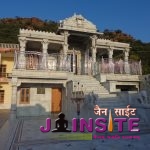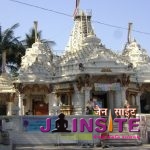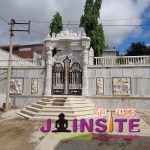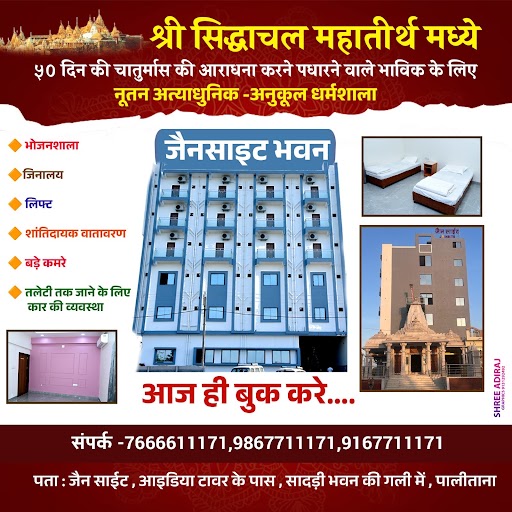SHRI CHITRAKUT TIRTH
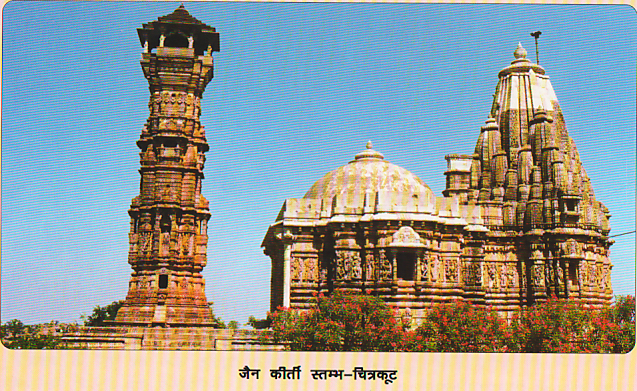
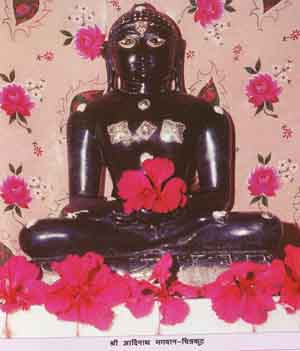
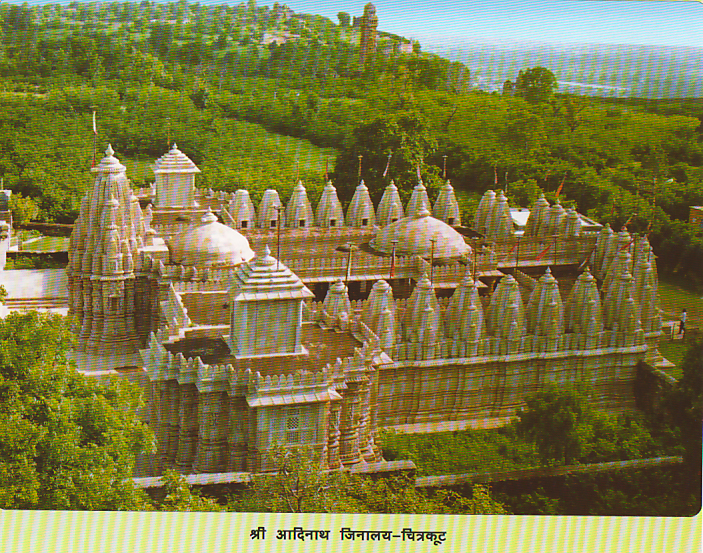
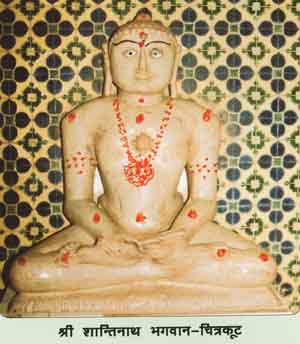
PRESIDING DEITY AND LOCATION :
Shri Adinath Bhagwan in white color, seated in a lotus posture and of height 35 Cms located in a shrine fortress, 5.6 Kms long and 0.8 Km wide on a mountain plateau 560 meters high above sea level. (Shve)
ANTIQUITY AND SALIENT FEATURES :
A reference is found that during 1st Vikram Century, Sri Siddhasen Diwakar who had the honor of being addressed a “Ratna” in the court of Emperor Vikramaditya, came and resided here with the object of learning. Acharya Sir Haribhadrasurishvarji who happened to live during Vikram’s eighth-ninth centuries was born here. The city then was famous under the name of “Madhyamika”.
This fortress having been built by Raja Chitrangad of Maurya dynasty is also known as “Chitrakut”. During 8th Vikram century Bapa Raval of GOhil dynasty the king of Mewad, conquered this fortress after defeating Raja Man of the Maurya dynasty. The fortress went under the authority of Siddharaj Jaisinh furing 12th century. It remained so also during the period of Raja Kumarpal till he gifted it over together with other 700 villages by a properly framed written document to Alik Kumbhar who had once saved his life. Several inscriptions are found of the period before Raja Kumarpal accepted Jainism as his religion in 1216. Thereafter king Samantsinh of Mewad of Gohil dynasty established his authority over this area in Vikram year 1231 after defeating Ajaypal, the nephew of Kumarpal.
And since then despite muslim rule Chittod continued to remain under the authority of Sisodia kings of Gohil dynasty.
It is stated that in Vikram year 1167, a temple of Sir Mahavir Bhagwan was constructed here. In the year 1169 a great festival was held here when the “Yugpradhan” Dada Sir Jinduttsurishvarji was ceremonially installed on the seat of Sri Jinvallabhsurishvarji on Vaishakh Sukla 1. Dada Suru’s previous name was Pandit Somchandra Gani. It is noteworthy that Dada Guru had succeeded in learning all secret and occult knowledge of Mantras preserved here in an iron pillar believed to contain everything that Vajraswami had composed centuries ago because of his yogic powers. Practice of these Mantras had given him perfect mastery over nature.
A reference is available that in Vikram year 1322, the chief of queen of Maharana Tejsinhji and the mother of Samarsinhji named Jaytalladevi constructed here a temple of Sri Parshvanath Bhagwan. It is also stated that in Vikram year 1355 on Falgun SUkla 5, a ceremony for hoisting a flag on the temple of Sri Adhinath Bhagwan was performed in the presence of Prince Amarsinhji. In Vikram year 1353 during the reign of Maharana Samarsinh, in 11 temples, the idols were ceremonially installed. The treasurer of Kumbha Rana Sri Vella in Vikram year 1505 had got an artistic temple built of Sri Shanthinath Bhagwan on the spot where the old temple was in ruins and had got the same properly consecrated and sanctified at the hands of Sri Jinsensurishvarji. The temple’s name was “Ashthapadavtar Sri Shanti Jinachaitya” which today is called “Shringarchouri”.According to “Soma Saubhagya Kavya” composed in Vikram year 1524, Shreshthi Shi Vishal inhabitant of Devkulpatak and revered by Sri Lakha Rana had built in the 15th century Sri Shreyansnath’s temple in the fort. During 15th century, Bal, son of Shresthi Sri Gunaraj after building an wxpansive but pretty Jain temple flanked on all sides small shrines of gods and goddess just adjacent to “Kirti Stamb” (The tower of fame) had got installed and ceremonially consecrated three Jain idols at the hands of Sri Somsundersurishvarji. It is also stated that during the period of Maharana Mokal his chief minister Sri Saranpalji had built here many Jain temples. It is also believed that the chief minister of Mandavgadh Sri Pethadshah had built a Jain temple here. In a Tirthmala composition by Sri Jaihem in Vikram year 1566 and by Gayandi the disciple of Sri Harshpramod in Vikram year 1563 it is stated that as many as 32 Jain temples including “Kirti Stamb” belonging to various Jain groups (Gachcha) existed here.
The construction period of this seven-storey Jain Kirti Stambh is believed to be of 12th century. It was constructed as a memorial to Bhagwan Sri Adhinath.
At present there are six Jain temples in the fort of Chittod, the largest and the main being that of Sri Rishabhdev Bhagwan. The spot where this temple surrounded by 52 shrines of goddesses and gods is known as “Sattavis Devri”. This is supposed to imply that at one time there existed here 27 small and large temples. In the compound of this temple there are two temples of Bhagwan Sri Parshvanath. In the area known as “rampole” within the fort, in one single compound there do exist today two temples viz., of Bhagwan Sri Mahavir Swami and Sri Shanthinath Bhagwan. The temple of Sri Shanthinath Bhagwan is a small one, it is adorned with and full of very high character. It is also known as “Shringarchouri”. Near gaumukhi kund there is a temple of Bhagwan Sri Parshvanath with four faces in all four directions.
The fort of Chittod is famous in India and this is why it is said “fort is only Chittod fort, all others are small fortress”. This is the land of the brave and countless kings and Jain ministers who lived here breathed their last after performing deeds of untold bravery. “Every brick and stone on this hill speaks eloquently of valor, patriotism and sacrifice and every temple and tower here points to its ancient culture. It had not only been a scene of battle but had also remained a great seat of learning and literature and art, architecture, rhyme and religion”. The magnificent Jain “Kirti Sthumbh” erected in 14th century still stands with pride and dignity every reminding one of the past glory of Jainism.
Shri Karmachandra Shah who was the donor to carry out repairs and renovations of Sri Shatrunjay temples for the 16th time in vikram year 1587 was the inhabitant of this place. The palace of Sri Bhamashah, the treasurer of Maharana Pratap was situated here.
A view below from the fort on this hill is pleasing to the eye. On a plateau of even land, so large on a mountain, such a big and strong fort os nowhere to be seen in India. The ruins and relics of ancient Jain temples are found here everywhere. The art in the temple of Sri Shanthinath Bhagwan known also as “Shringarchouri” is indeed remarkable. The icon is impressively beautiful. The art in every temple here compares favourably with that found in Mewad, Dilwara, Kumbharia etc., Many old water ponds, ruined palaces, kunds, buildings, etc., appear scattered here every where. In the majestic temple of Sri Mirabai, main Jain images can be observed. The architectural style and art in the Jain “Kirthi Stambh” is worth seeing.
APPROACH – ROUTE :
The nearby railway station of Chittodgadh junction is 7Kms away from the temples ion Chittod fort and is on the Ajmer-Khandwa railway line. From the railway station buses and taxis are available. There is a tar road upto the temple.
AMENITIES FOR JAIN PILGRIMS :
There is a new dharamshala with all the facilities including a bhojanshala just opposite to the Chittodgadh railway station. There is dharamshala near the temple, which is at the fort, too but only with the facility of water and electricity.
MANAGED BY :
Shri Sattavis Devari Jain Swetamber Mandir Trust Jain Dharamshala
Railway Station Road,
P.O. chittodgadh – 312 001
Dist : Rajasthan
Tel : 01472-41971 (Pedhi Office)
01472-42162 (Fort Office)


